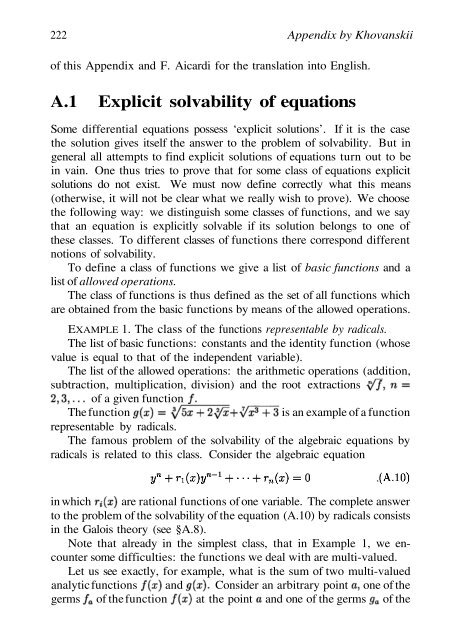Abel's theorem in problems and solutions - School of Mathematics
Abel's theorem in problems and solutions - School of Mathematics
Abel's theorem in problems and solutions - School of Mathematics
You also want an ePaper? Increase the reach of your titles
YUMPU automatically turns print PDFs into web optimized ePapers that Google loves.
222 Appendix by Khovanskii<br />
<strong>of</strong> this Appendix <strong>and</strong> F. Aicardi for the translation <strong>in</strong>to English.<br />
A.1 Explicit solvability <strong>of</strong> equations<br />
Some differential equations possess ‘explicit <strong>solutions</strong>’. If it is the case<br />
the solution gives itself the answer to the problem <strong>of</strong> solvability. But <strong>in</strong><br />
general all attempts to f<strong>in</strong>d explicit <strong>solutions</strong> <strong>of</strong> equations turn out to be<br />
<strong>in</strong> va<strong>in</strong>. One thus tries to prove that for some class <strong>of</strong> equations explicit<br />
<strong>solutions</strong> do not exist. We must now def<strong>in</strong>e correctly what this means<br />
(otherwise, it will not be clear what we really wish to prove). We choose<br />
the follow<strong>in</strong>g way: we dist<strong>in</strong>guish some classes <strong>of</strong> functions, <strong>and</strong> we say<br />
that an equation is explicitly solvable if its solution belongs to one <strong>of</strong><br />
these classes. To different classes <strong>of</strong> functions there correspond different<br />
notions <strong>of</strong> solvability.<br />
To def<strong>in</strong>e a class <strong>of</strong> functions we give a list <strong>of</strong> basic functions <strong>and</strong> a<br />
list <strong>of</strong> allowed operations.<br />
The class <strong>of</strong> functions is thus def<strong>in</strong>ed as the set <strong>of</strong> all functions which<br />
are obta<strong>in</strong>ed from the basic functions by means <strong>of</strong> the allowed operations.<br />
EXAMPLE 1. The class <strong>of</strong> the functions representable by radicals.<br />
The list <strong>of</strong> basic functions: constants <strong>and</strong> the identity function (whose<br />
value is equal to that <strong>of</strong> the <strong>in</strong>dependent variable).<br />
The list <strong>of</strong> the allowed operations: the arithmetic operations (addition,<br />
subtraction, multiplication, division) <strong>and</strong> the root extractions<br />
<strong>of</strong> a given function<br />
The function is an example <strong>of</strong> a function<br />
representable by radicals.<br />
The famous problem <strong>of</strong> the solvability <strong>of</strong> the algebraic equations by<br />
radicals is related to this class. Consider the algebraic equation<br />
<strong>in</strong> which are rational functions <strong>of</strong> one variable. The complete answer<br />
to the problem <strong>of</strong> the solvability <strong>of</strong> the equation (A.10) by radicals consists<br />
<strong>in</strong> the Galois theory (see §A.8).<br />
Note that already <strong>in</strong> the simplest class, that <strong>in</strong> Example 1, we encounter<br />
some difficulties: the functions we deal with are multi-valued.<br />
Let us see exactly, for example, what is the sum <strong>of</strong> two multi-valued<br />
analytic functions <strong>and</strong> Consider an arbitrary po<strong>in</strong>t one <strong>of</strong> the<br />
germs <strong>of</strong> the function at the po<strong>in</strong>t <strong>and</strong> one <strong>of</strong> the germs <strong>of</strong> the

















